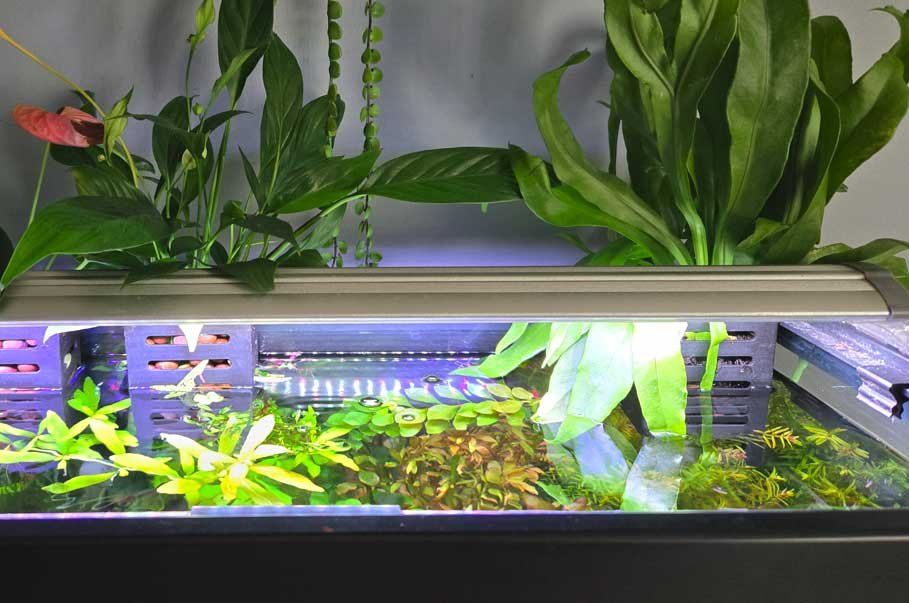
Aquarium Lighting: How to choose the best light
Proper lighting is essential for the health and well-being of your aquarium’s inhabitants. It affects everything — from plant growth to fish behavior. Choosing the right fish tank light means creating an environment that supports both the biological needs of your aquatic life and the aesthetic you’re aiming for.
For beginners and pros alike, selecting the best aquarium light for plants is one of the most important decisions in building a thriving aquatic ecosystem. Whether you’re running a planted tank, a fish-only setup, or a nano aquascape, this guide will help you make the right choice.
Why Aquarium Lights for Plants Matter
For freshwater aquariums, the lighting requirements can vary based on whether you have a heavily planted tank or a fish-only setup.
If you’re keeping live plants, then lighting isn’t optional — it’s vital. Good aquarium lights for plants promote healthy photosynthesis, vibrant colors, and balanced growth. Poor lighting, on the other hand, can cause algae blooms, plant melt, or stress in fish.
LED lighting has become the gold standard for aquariums — and for good reason.
You’ll find LEDs in every size and price range, offering full-spectrum output, low power consumption, and smart features like app control or sunrise/sunset simulation.
So let’s be clear: if you’re setting up a planted aquarium, all you need is a solid LED fish tank light that fits your tank’s size and depth.
Choosing the Right Light for your Aquarium
Finding the best planted aquarium light means looking at a few key factors:
- Aquarium type (planted vs fish-only)
- Types of plants and fish
- Tank depth and size
- Light spectrum and intensity
For planted tank lighting, go for full-spectrum LED lights that simulate natural daylight. These not only look amazing but also support robust plant growth.
🔆 Understanding Light Intensity
Light intensity is crucial for plant health — and comfort for your fish. Some shy species like bettas prefer dim lighting, while cichlids thrive in brighter conditions.
Here’s a simple guide to light intensity for planted tank lights:
| Light Level | Watts/Gallon | Ideal For |
|---|---|---|
| Low Light | 0.5–1 W/gal | Java Fern, Anubias, Cryptocoryne |
| Medium Light | 1–2 W/gal | Amazon Sword, Bacopa, Java Moss |
| High Light | 2–3 W/gal | Rotala, Cabomba, Alternanthera |
🌈 Color Temperature & Spectrum
Light color is measured in Kelvin (K) and influences plant growth and how your aquarium looks:
- 6,500K–10,000K: Natural daylight spectrum — perfect for photosynthesis and a vibrant, natural appearance
- 2,700K–3,000K: Warm light — good for tropical fish, less ideal for plant growth
To get the most out of your aquarium lights for plants, stick to full-spectrum LEDs within the 6,500–8,000K range.
📏 Lighting & Aquarium Depth
As light passes through water, it loses strength. That’s why depth matters when choosing a planted aquarium light. What you need to understand is PAR (Photosynthetically Active Radiation) — the amount of usable light plants can absorb.
💡 Rule of thumb: Light intensity drops by 10–20% for every inch of water depth.
If you have a deep tank (over 18 inches), look for LEDs with higher PAR output and even distribution.
Aquarium Lighting Maintenance Tips
To keep your fish tank light effective:
- Clean regularly: Dust and algae on your light fixture can block light output
- Monitor plant health: Wilting or pale plants may signal lighting issues
- Use a timer: 6–8 hours of light per day is enough for most planted aquariums
Pro tip: Some planted tank lights offer built-in timers and simulate sunrise/sunset. It’s a beautiful, gentle way to mimic nature.
How Long Should You Leave Aquarium Lights On?
The natural day-night cycle is about 12 hours of light and 12 of darkness. But in a closed system like an aquarium, too much light = algae growth.
The ideal range? 6 to 8 hours per day.
⚠️ Too much light fuels algae. Too little, and your plants won’t grow.
Curious Fact:
Some aquatic plants, like Rotala, exhibit leaf movements throughout the day in response to the light cycle. After several hours of light, you may notice that their leaves begin to fold slightly or “close,” almost as if the plant were going to sleep. This behavior, known as nyctinasty, is a natural response tied to their internal rhythm and often indicates that the plant has received enough light for the day. It’s a subtle but fascinating sign that your plants are healthy and in tune with their environment — and it can also be a gentle cue that it’s time to turn off the lights.
Best lighting brands for Aquariums
In my experience, the best planted aquarium light is one that balances intensity, durability, and ease of use, and you can achieve great results even with a modest budget, as long as it aligns with the specific needs of your project.
Here are my top picks for planted aquarium lighting based on years of testing. Remember the key is choosing the one that best suits your particular setup.
1. Fluval
- Full-spectrum LEDs
- Great for both fish-only and planted tanks
- Sleek, energy-efficient, long lifespan
2. Finnex
- Fantastic for budget setups
- Good PAR for low- to medium-light plants
- Ideal for small to mid-sized planted aquariums
3. Hygger
- Excellent price-performance ratio
- Adjustable brightness and spectrum
- My personal favorite for everyday setups
“Personally, I use Hygger for my 10-20 Gal planted tanks. The plants bubble, stay vibrant, and grow steadily — all without spending a fortune.”
Bonus mentions: Twinstar and Chihiros are premium options, great for serious aquascaping. But if you’re just starting, they might be overkill for your budget.
FAQ Aquarium Lighting
Final Thoughts: Light Smart, Grow Better
According to the University of Florida, light is one of the most important factors affecting aquatic plant photosynthesis and growth. Choosing the right aquarium lighting for plants isn’t just about brightness — it’s about balance.
Pick the light that fits your setup, your plant selection, and your fish’s behavior. Even with a modest budget, you can achieve stunning results — as long as you respect the needs of your ecosystem.
In my case, using LED lights like Hygger has been a game changer. I’ve seen lush growth, clear water, and happy fish — without overcomplicating anything.
So go ahead: light it up, plant it out, and watch your aquarium come to life.








